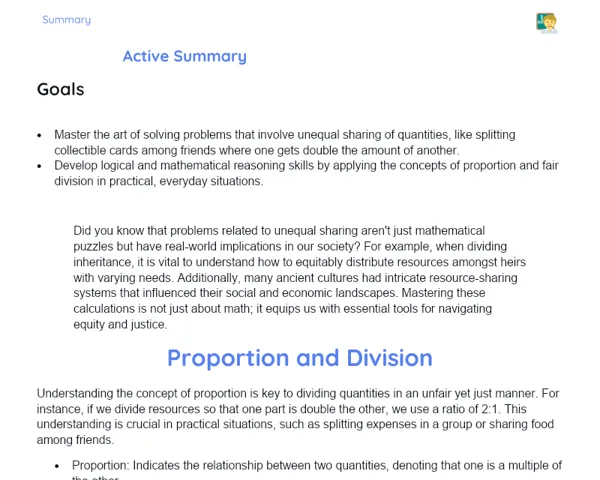Socioemotional Summary Conclusion
Goals
1. Understand the definition and differences between lines, rays, and line segments.
2. Identify and classify the possible positions between two lines: parallel, intersecting, and coincident.
3. Relate mathematical concepts to everyday situations and emotions, fostering self-awareness and empathy.
Contextualization
Have you ever imagined driving on the endless roads of National Highways? Or walking along a path that starts at a particular point and leads on forever? 🛤️ This is quite reminiscent of what we study when we look at lines in mathematics! They might seem abstract, but getting to grips with lines, rays, and line segments can assist us in tackling geometry problems and even understanding our own journeys and how we relate with others. Let’s dive into these ideas together and see how they appear in our daily lives and social interactions! 🚀
Exercising Your Knowledge
Lines
Picture a road extending infinitely in both directions, with no beginning or end in sight. This is how a line operates in mathematics. It is a continuous stretch that has no limitations. Just like our choices and actions can influence the future in unpredictable ways, lines signify endless possibilities in the space around us.
-
A line is an endless stretch: Just like a highway that goes on forever, a line extends indefinitely in both directions.
-
It has no starting or ending point: Unlike other geometric shapes, a line does not begin or end.
-
Symbol of continuity and possibilities: Just like our life's choices, lines represent a continuous trail with infinite routes ahead.
Rays
Imagine a path that begins at a specific point and continues forever in one direction. That’s a ray. In mathematical terms, a ray starts from a distinct point but extends infinitely in a single direction. This concept helps us reflect on how certain decisions or events have a set starting point, while their impacts can stretch indefinitely.
-
A ray has a starting point: Unlike lines, rays have a specific beginning.
-
Extends infinitely in one direction: From the given starting point, the ray goes on endlessly in one direction.
-
Represents a beginning with lasting consequences: Just like a significant decision can originate from one moment and yield long-term impacts, rays represent events that develop over time.
Line Segments
Think of a particular stretch of road you drive between two junctions. This is a line segment. Unlike lines and rays, a line segment has defined starting and ending points. This concept can teach us the value of setting clear boundaries and goals in our lives.
-
A line segment has a starting and ending point: Unlike lines and rays, segments have specific limits.
-
Represents a defined stretch: Like a certain period or phase in our lives, a line segment is a distinct part of a whole.
-
Importance of clear objectives: By establishing starting and ending points, we can work towards our goals and better comprehend the path we've taken.
Key Terms
-
Line: An infinite stretch that extends endlessly in both directions, without a beginning or an end.
-
Ray: A line that commences at a certain point and extends infinitely in one direction.
-
Line Segment: A portion of a line with a defined beginning and end.
For Reflection
-
How can you connect the concept of an infinite line to the possibilities and choices in your life?
-
Think of a crucial decision you made. In what ways does that decision resemble a ray, with a starting point and long-term outcomes?
-
What are the 'line segments' in your life? How do you differentiate the beginnings and ends of various phases or projects you embark upon?
Important Conclusions
-
We have understood the definitions and differences between lines, rays, and line segments.
-
We have learned to identify and categorize the potential positions between two lines: parallel, intersecting, and coincident.
-
We have linked these mathematical concepts to real-life situations and emotions, fostering self-awareness and empathy.
Impacts on Society
Lines, rays, and line segments aren't just abstract mathematical concepts; they have real-world applications in our daily lives. For instance, architects and engineers utilize them to design and safely construct buildings. By grasping these principles, we also improve our problem-solving abilities in geometry and logic, which are vital skills in various professions and everyday scenarios.
Moreover, forming an emotional connection with these mathematical ideas can lead to introspection regarding our own journeys and social interactions. Viewing our lives as a continuum of lines and segments helps us acknowledge moments of transition and continuity, aiding us in managing our experiences and feelings. Thus, mathematics evolves into not merely a tool for problem-solving, but also a vehicle for self-exploration and personal development.
Dealing with Emotions
Let’s engage in a simple exercise to manage our emotions while studying mathematics and its practical applications. First, identify how you feel when encountering geometry challenges: you might feel curious, frustrated, or even excited. Try to understand the root of these feelings; perhaps a specific difficulty or a recent achievement triggers them. Label these emotions: anxiety, satisfaction, etc. Express these feelings in a constructive manner—whether through journaling or discussing with someone. Lastly, regulate these emotions by discovering strategies that work for you, such as taking breaks to unwind, practicing deep breaths, or even trying guided meditation.
Study Tips
-
Create diagrams and sketches: Visualize lines, rays, and line segments through drawings. This helps in understanding and memorizing concepts.
-
Practice with real-life examples: Observe objects and situations around you that can be represented by these concepts, such as roads, railway tracks, and routes you frequently traverse.
-
Utilize online resources: There are plenty of websites and apps offering interactive exercises and informative videos on geometry. Make the most of these resources to solidify your learning.



